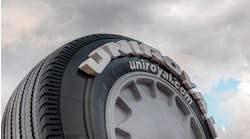When the telephone rings at your store, the odds are better than two to one that your customer or prospect is using a cell phone or one of the newer “smartphones.” Today, there are more than 280 million mobile phones in use by about 80% of Americans, age 18 and above.
In one recent survey, 75% of respondents said they keep their cell phones on and within reach during waking hours! Most users feel that the cell phone has made their life easier by providing instant wireless access wherever they happen to be at the time. There are many funny stories about cell phone call locations.
The days of wired telephone service are numbered. For example, last month, I cancelled my land line business telephone service and ported the existing number to my new Blackberry smartphone.
From the time on March 10, 1876, when Alexander Graham Bell spoke the first sentence into his invention, the telephone has become an essential communication device. Telephone use, both personal and business, exploded during the ensuing decades. Perhaps you may still recall the black, rotary dial models, connected by operators using a tangle of wires. I sure remember them. Today, most equipment is digital, wireless, mobile, and with Internet connectivity built in.
The changes actually have made telephone use even more vital to a tire dealer’s success. Customers and prospects have immediate access to an enormous amount of information, and they use their 24/7 connectivity to shop and find the products and services they need.
Although telephone technology has rapidly evolved in the past few years, the need for friendly, attentive telephone etiquette remains the same. A caller determines his or her first impression of your company during the first half-minute of your conversation. The person answering your telephone is the whole company during those crucial moments.
You need repeat business and referrals from delighted customers. That means you should pay particular attention to your firm’s telephone etiquette.
• For Pete’s sake, avoid putting mobile phone users on hold for lengthy periods. Delays on hold eat valuable cell phone minutes.
• Show that you value the caller’s time. If you must put someone on hold, check back every 30 to 45 seconds or your caller may think he or she is no longer connected, hang up, and call your competitor! If you cannot connect the caller quickly, ask if it would be better to take the caller’s number and have your person call them back shortly.
• Just as the first few seconds of a call create the caller’s first impression of your operation, the last seconds establish the caller’s final opinion. Try to end on a brief, but friendly note. People will sense your smile.
I am the curious type, so I decided to make a few calls to a random sample of tire dealers and determine a subjective range of telephone etiquette. I made seven calls to tire dealers in five states, coast to coast. Three were to locations of major independent chains. Four were independent tire dealers. All seven dealers responded pretty well.
[PAGEBREAK]
Answering the call
All seven answered my call promptly in one or two rings. In three cases, I was asked to hold, but my wait on hold only lasted from three to 12 seconds.
The initial store greetings varied. In five cases, the greetings were OK. The usual answer was the dealer’s name, along with the person’s name, and “How may I help you?” The greetings were friendly and not too long-winded.
Two dealers used a central operator who then directed my call to someone else who could help me. The process was efficient, but a bit less friendly at the beginning of the call.
One fellow at a major chain in Maryland answered on the first ring but he spoke too fast and I missed both the dealership name and his name. I had to ask him to repeat. He was friendly and helpful once we began to talk tires.
Every dealer quoted me prices on four new tires for my car after I told them the make and model, and the tire size I was using. They asked about my type of driving, or about the type of tire that I was interested in buying.
Four of the seven dealers offered more than one brand, discussing different mileage warranties and quoting a range of prices. The other three made a single recommendation based on my stated desire for a touring tire with long life.
Prices for four P215/60R16 tires ranged between $420 and $670 installed, tax included, depending on brand and mileage warranty. The quotes covered 11 different tire brand and model combinations.
One dealer in Erie, Pa., listed for me all of the extras that were in the final price, including computer balancing, rotations, alignment checks, road hazard warranty, and nitrogen inflation.
Looking back on my conversations, I must give Anthony, the independent tire dealer in Erie, the nod for my best telephone tire shopping experience. He was friendly, helpful, and he provided extra information that made me want to buy from him. Anthony was also one of the three dealers who actually asked for my business or asked me to call back and give them the last shot at the deal.
Oddly enough, not one dealer asked for my name. It is easy to overcome that shortcoming. Politely asking for the caller’s name can create a stronger person-to-person link. The dealer should then repeat the caller’s name during the conversation.
Why not call your own store(s), and pose as a potential customer? You will quickly learn how well, or how poorly, your company handles customer and prospect calls. [PAGEBREAK]
Effective inbound calls
Most tire dealers will say that their customers are “Number One.” Does the manner in which your people handle telephone calls show that customers are “Number One” over the phone, too?
Studies show that the tone one uses on the telephone conveys as much or more than the words used. Your tone of voice is a major part of your message, so take a deep breath and answer with a smile. Do you not appreciate a friendly, helpful voice when you make a call? Look at it this way, a caller could constitute a piece of your next paycheck.
• Slow down a little when you pick up the telephone. State the company’s name and your own name, then ask how you may help the caller. It is important to remember that cell phone reception varies and may not be as clear as a land line connection. Keep the conversation on a friendly person-to-person level.
• Answer questions quickly, politely, and fully. Put your customer’s time and needs ahead of your own busy schedule.
• Try to avoid background noise and other distractions.
• Listen and get the caller’s name and concerns right the first time.
• Remember, your tone of voice is important, perhaps the most important, part of your message.
• Try to avoid sending a caller to “voice mail jail.” If you feel you must put the caller into voice mail, be sure to ask their permission to do so first. Gaining the caller’s permission makes all the difference in how your caller perceives voice mail.
Effective outbound calls
Telemarketing can reduce your sales cycle time and improve your success ratio. Because so many of your customers and prospects now use wireless mobile devices, you must be acutely aware of their time.
The Boy Scout motto, “Be prepared,” is good advice when calling out. Proper telephone etiquette is essential when making outbound telephone sales calls.
• Know in advance with whom you need to speak. If you call another business and you are not sure who to ask for, start at the top of the hierarchy and work down.
• Respect your prospect’s time. Ask for permission to continue the conversation after the first greeting. “Is this a good time to talk?”
• If necessary, schedule a specific call back time.
• Have a list of specific things you want to know. A useful format is to ask a question, listen carefully to the answer, quickly confirm what you understood your prospect to say, and then ask your next question. Stay focused.
If you are unable to make any progress, try a different approach. Most salespeople surrender after just one try. Persistence pays.
[PAGEBREAK]
When the prospect needs more information, try to advance your sales process. There is a big difference between advancing and merely continuing the process. You advance when you get the prospect’s verbal commitment to review any additional information you send, and set up a date and time for your call back. When your prospect refuses to agree to review or schedule your next call, it is likely that you are simply getting the old brush-off.
Customer follow-up is another helpful form of outbound marketing. Many car dealerships call service customers a day or two after a visit to make sure the customer is happy with the products and services. Make the calls during brief lulls in activity. A call may result in a raving fan or it may call for some remedial action that helps you retain an unhappy customer. Car manufacturers audit their dealers’ customer satisfaction; why not make the same effort?
Wireless marketing opportunities
The explosive growth of smartphones means new ways to market your tires and services. You now can reach a vast audience of mobile phone users instantly and at a much lower cost.
Instant wireless communication allows tire dealers to build tighter relationships with customers and gain more new business referrals. Applications now exist that allow merchants to create and redeem gift cards, loyalty plans, and coupons electronically. Offers reach potential buyers at the speed of light, and without the usual printing and mailing expenses.
Smartphones make it easy for your customers to pass along your offers to their networks of friends, using Facebook, Twitter, LinkedIn and other social networks. You can even create coupons that customers cannot use, but only pass on to friends. You can create new business through this new mode of customer referrals.
It pays to get closer to customers and stay tuned to their levels of satisfaction. Today, online blogs allow customers to tell the world whether they are happy or unhappy with a particular company. You may be surprised to find that customers are rating you daily on one or more local review blogs. Determine if blogs are already rating your business. If they are not, you may want to consider adding a blog page to your existing Web site to make it easy to gather and monitor customer feedback.
Instant wireless communication is now a fact of business life. Customers have creative new ways to shop for tires and automotive services both online and by telephone. What has not changed yet is your need for correct telephone etiquette, a friendly tone of voice, and a knowledgeable person who sincerely wants to make it easy for that customer or new prospect to do business with you.
Dick Morgan is a Certified Management Consultant (CMC) and president of Morgan Marketing Solutions Inc., Dallas, Texas. Morgan helps leaders tackle major issues and become better marketers, using a holistic business approach. He has been involved in the tire and rubber industry since 1974, as senior vice president of marketing for Long Mile Rubber Co. Since 1989, he continues to provide business advisory services to tire dealers, retreaders and rubber manufacturers. Morgan is one of the judges for Modern Tire Dealer’s Tire Dealer of the Year. For more information, see his Web site at www.morganmarketingsolutions.com or call (972) 931-7993.


